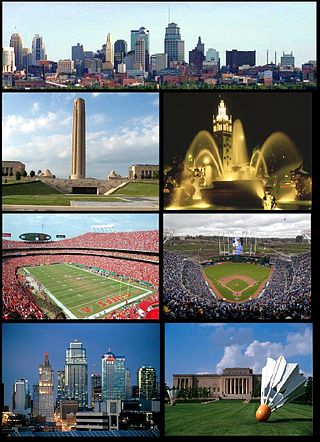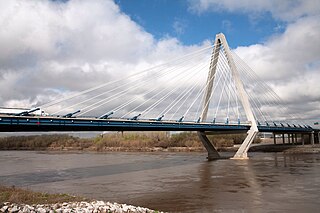
Kansas City, Missouri is the largest city in the U.S. state of Missouri by population and area. Most of the city lies within Jackson County, with portions spilling into Clay, Platte, and Cass counties. It is the central city of the Kansas City metropolitan area, which straddles the Missouri–Kansas state line and has a population of 2,392,035. As of the 2020 census, the city had a population of 508,090, making it the 37th most-populous city in the United States, as well as the sixth-most populous city in the Midwest. Kansas City was founded in the 1830s as a port on the Missouri River at its confluence with the Kansas River from the west. On June 1, 1850, the town of Kansas was incorporated; shortly after came the establishment of the Kansas Territory. Confusion between the two ensued, and the name Kansas City was assigned to distinguish them soon after.

Jackson County is located in the western portion of the U.S. state of Missouri, on the border with Kansas. As of the 2020 census, the population was 717,204. making it the second-most populous county in the state.

Independence is the 5th most populous city in Missouri and the county seat of Jackson County. Independence is a satellite city of Kansas City, Missouri, and is the largest suburb on the Missouri side of the Kansas City metropolitan area. In 2020, it had a total population of 123,011.

Arrowhead Stadium is an American football stadium in Kansas City, Missouri. It primarily serves as the home venue of the Kansas City Chiefs of the National Football League (NFL). The stadium has been officially named GEHA Field at Arrowhead Stadium since March 2021, following a naming rights deal between GEHA and the Chiefs. The agreement began at the start of the 2021 season and ends in January 2031 with the expiration of the leases for the Chiefs and Royals with the stadium's owner, the Jackson County Sports Complex Authority.

Lamar Hunt was an American businessman most notable for his promotion of American football, soccer, and tennis in the United States.

The Kansas City metropolitan area is a bi-state metropolitan area anchored by Kansas City, Missouri. Its 14 counties straddle the border between the U.S. states of Missouri and Kansas. With 8,472 square miles (21,940 km2) and a population of more than 2.2 million people, it is the second-largest metropolitan area centered in Missouri and is the largest metropolitan area in Kansas, though Wichita is the largest metropolitan area centered in Kansas. Alongside Kansas City, Missouri, these are the suburbs with populations above 100,000: Overland Park, Kansas; Kansas City, Kansas; Olathe, Kansas; Independence, Missouri; and Lee's Summit, Missouri.

Kansas City Municipal Stadium was an American baseball and football stadium in the central United States, located in Kansas City, Missouri. It was located at the corner of Brooklyn Avenue and E. 22nd Street.

The history of the Kansas City metropolitan area has significant records since the 19th century, when Frenchmen from St. Louis, Missouri moved up the Missouri River to trap for furs and trade with the Native Americans. This strategic point for commerce and security at the confluence of the Kansas and Missouri Rivers became the Kansas City metropolitan area, straddling the border between Missouri and Kansas. Kansas City, Missouri was founded in 1838 and surpassed the competing Westport to become the predominant city west of St. Louis. The area had a major role in the westward expansion of the United States. The Santa Fe and Oregon trails ran through the area. In 1854, when Kansas was opened to Euro-American settlement, the Missouri-Kansas border became the first battlefield in the conflict in the American Civil War.

The Paseo Bridge was a suspension bridge over the Missouri River in Kansas City, Missouri. Before being replaced by the Christopher S. Bond Bridge, it carried Interstates 29 and 35 and U.S. Route 71 over the river. It was named for The Paseo, a boulevard that connected with the bridge to the south, and continues to do so with the Bond Bridge.

The Barstow School, previously called Miss Barstow’s School 1884 known as oldest private school for girls in Kansas City, is a secular, coeducational, independent preparatory school in Kansas City, Missouri, USA. It was co-founded in 1884 by Mary Louise Barstow and Ada Brann.

The Paseo is a major north–south parkway in Kansas City, Missouri. As the city's first major boulevard, it runs approximately 10 miles (16 km) through the center of the city: from Cliff Drive and Lexington Avenue on the bluffs above the Missouri River in the Pendleton Heights historic neighborhood, to 85th Street and Woodland Avenue. The parkway holds 223 acres (0.90 km2) of boulevard parkland dotted with several Beaux-Arts-style decorative structures and architectural details maintained by the city's Parks and Recreation department.

The Christopher S. Bond Bridge in Kansas City, Missouri is a cable-stayed bridge across the Missouri River. It carries I-29/I-35/US 71. The bridge opened to limited traffic on September 27, 2010, and all lanes opened on December 18, 2010. The Bond bridge is a replacement for the Paseo Bridge.
Linwood Boulevard is a boulevard and major east–west street in Kansas City, Missouri, United States. Linwood begins at Broadway Boulevard in the Valentine and Old Hyde Park neighborhoods and travels 3.8 miles east through Midtown to Van Brunt Boulevard near Interstate 70 in the Kansas City East Side. For much of its length, it creates a high-density corridor with 31st Street, another major street running parallel one block north. It continues west of Broadway Boulevard as 33rd Street past Metropolitan Community College-Penn Valley. Linwood Boulevard is one of the few named east–west streets in the Kansas City grid south of the Missouri River.
Prospect Avenue is one of the major north-south streets in Kansas City, Missouri and the Kansas City metropolitan area. It begins in the north at E Reservoir Drive in the Pendleton Heights neighborhood of the Historic Northeast and stretches south for 10.5 miles to its southern terminus at Blue River Road. It runs closely parallel to U.S. Route 71 from Swope Parkway to 75th Street.

Kansas City Union Station is a union station opened in 1914, serving Kansas City, Missouri, and the surrounding metropolitan area. It replaced a small Union Depot from 1878. Union Station served a peak annual traffic of more than 670,000 passengers in 1945 at the end of World War II, quickly declined in the 1950s, and was closed in 1985.
The following is a timeline of the history of the city of Philadelphia, Pennsylvania.
The following is a timeline of the history of the city of Atlanta, Georgia, United States.
The following is a timeline of the history of the city of Austin, Texas, USA.
The following is a timeline of the history of the city of St. Louis, Missouri, United States.
The following is a general historical timeline of the city of Los Angeles, California in the United States of America.












